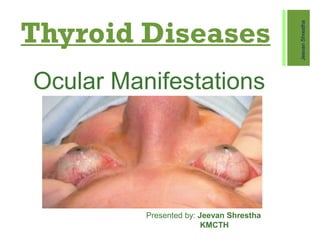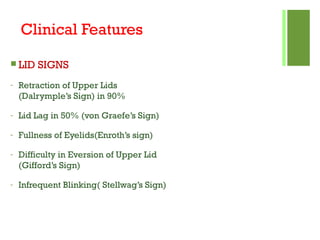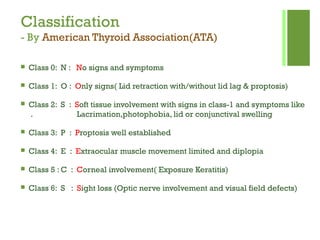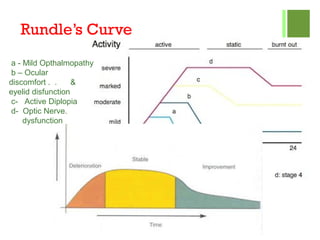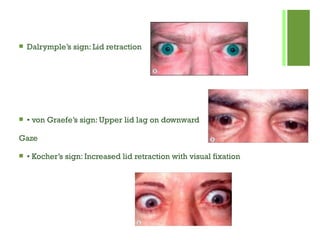THYROID EYE DISEASE
- 1. Thyroid Diseases Ocular Manifestations JeevanShrestha Presented by: Jeevan Shrestha KMCTH
- 2. ïŪ I have no conflict of interest or disclosure in relation to this presentation.
- 3. Thyroid Disorders ïŪ Graveâs Disease ïŪ Hashimoto's Thyroiditis ïŪ Thyroid Carcinoma ïŪ Primary Hyperthyroidism ïŪ Neck Irradiation JeevanShrestha
- 4. Graveâs Ophthalmopathy ïŪ Is an autoimmune inflammatory disorder affecting the orbit around the eye, characterized by upper eyelid retraction, lid lag, swelling, redness, conjunctivitis, and bulging eyes. ïŪ Various Names: ïŪ Thyroid Eye Disease(TED) ïŪ Thyroid-associated Ophthalmopathy (TAO) ïŪ Dysthyroid Ophthalmopathy ïŪ Thyroid Orbitopathy ïŪ Endocrine Ophthalmopathy
- 5. ïŪ Sex: More common in female than male 4:1 ïŪ Smoking ïŪ Middle age ïŪ Autoimmune thyroid disease ïŪ HLA-DR3 and HLA-B8 ïŪ TED associated with Hyperthyroidism(90%), Hypothyroidism(4%), Euthyroidism(6%) Risk factors
- 6. Onset ïŪ 20% of TED is diagnosed same time as hyperthyroidism ïŪ 60% of eye disease occur after 1 year of thyroid disease ïŪ Only 30% of hyperthyroidism ï TED
- 7. Pathogenesis ïŪ Inflammatory targets: ïŪ Primary: Orbital fibroblast ïŪ Secondary: Extraocular muscles ïŪ Activated T-cells act and stimulate adipogenesis, fibroblast proliferation and glycosaminoglycan synthesis. ïŪ Enlargement of extraocular muscles due to edema and infiltration ïŪ Orbital soft tissue infiltrated with lymphocytes, macrophages and mast cells
- 8. Pathogenesis ïŪ Autoimmune disorder(IgG mediated) ïŪ Enlargement of Extraocular Muscles - By Increase in Glycosaminoglycans ïŪ Cellular Infiltration of Interstitial Tissues - With lymohocytes, plasma cells and macrophages, mast cell - Fibrosis ïŪ Proliferation of Orbital fat, Connective tissue and Lacrimal Gland - With retention of fluid and GAG
- 9. Graveâs Ophthalmopathy Axial CT Extraocular Muscle Enlargement (Fusiform Appearance)
- 10. Clinical Features ïŪ LID SIGNS - Retraction of Upper Lids (Dalrympleâs Sign) in 90% - Lid Lag in 50% (von Graefeâs Sign) - Fullness of Eyelids(Enrothâs sign) - Difficulty in Eversion of Upper Lid (Giffordâs Sign) - Infrequent Blinking( Stellwagâs Sign)
- 11. Clinical Features ïŪ Conjunctival Signs: - Deep Injection and Chemosis ïŪ Pupillary Signs: - Unequal dilated pupils ïŪ Occular Motility Defects: - - Mobiusâs sign ïŪ Exophthalmos (60%) ïŪ Exposure Keratitis and ocular discomfort ïŪ Optic Neuropathy
- 12. Classification - By American Thyroid Association(ATA) ïŪ Class 0: N : No signs and symptoms ïŪ Class 1: O : Only signs( Lid retraction with/without lid lag & proptosis) ïŪ Class 2: S : Soft tissue involvement with signs in class-1 and symptoms like . Lacrimation,photophobia, lid or conjunctival swelling ïŪ Class 3: P : Proptosis well established ïŪ Class 4: E : Extraocular muscle movement limited and diplopia ïŪ Class 5 : C : Corneal involvement( Exposure Keratitis) ïŪ Class 6: S : Sight loss (Optic nerve involvement and visual field defects)
- 13. Rundleâs Curve a - Mild Opthalmopathy b â Ocular discomfort . . & eyelid disfunction c- Active Diplopia d- Optic Nerve. dysfunction
- 14. Diagnosis ïŪ Graveâs Ophthalmopathy: ïŪ 10-20% Precede hyperthyroid ïŪ 40% Concurrent ïŪ 30% < 6 months after diagnosis ïŪ 10-20% > 6 moths after Dx
- 15. Investigations ïŪ Thyroid Function Tests: - Serum T3,T4,TSH ïŪ Positional Tonometry: ïŪ Ultrasonography: - Changes in extraocular muscles ïŪ Computerised tonographic scanning: - Show proptosis, Muscle thickness, Optic Nerve thickening ïŪ MRI(T2- weighed and STIR): ïŪ Orthoptic workup:
- 16. Treatment A) Non- surgical Management: - Smoking Cessation - Head elevation at night & cold compressors in morning(Reduce periorbital edema) - Lubricating artificial tear drops - Eyelid taping - Guanethidine 5% eyedrop ( Decrease lid retraction) - Prisms - Systemic steroids - Radiotherapy - Combined therapy : ( Low dose steroids + Azathioprine + Irradiation)
- 17. Treatment (B) Surgical Management: i)Orbital Decompression: - Two wall Decompression (Orbital floor and medial wall removed) - Three wall Decompression (Floor, medial and lateral wall removed) - Four wall Decompression ( Three wall removal plus lateral half of roof and. . . large portion of sphenoid at apex) ii) Extraocular muscle surgery: - Always done after orbital decompression - To achieve binocular single vision in reading position
- 18. Treatment iii) Eyelid Surgery : - Mullerotomy - Levator recession/disinsertion - Scleral grafts - Recession of lower eyelid retractors - Blepheroplasty
- 21. ïŪ Dalrympleâs sign: Lid retraction ïŪ âĒ von Graefeâs sign: Upper lid lag on downward Gaze ïŪ âĒ Kocherâs sign: Increased lid retraction with visual fixation
- 22. ïŪ âĒ Balletâs sign: Palsy of one or more extraocular muscles ïŪ âĒ Sukerâs sign:Weakness of fixation on lateral gaze ïŪ âĒ Cowenâs sign: Jerky papillary contraction to consensual light ïŪ âĒ Kniesâ sign: Unequal dilatation of the pupils ïŪ âĒ Jeffreyâs sign: Absence of forehead wrinkling on upward gaze ïŪ Griffithâs sign: Lower lid lag on downward gaze ïŪ âĒ Stellwagâs sign: Infrequent blinking ïŪ âĒ Enrothâs sign: Puffy swelling of the lids ïŪ âĒ Mobiusâ sign:Weakness of convergence mobius
- 23. THANK YOU Marty Feldman Presented By : Jeevan Shrestha
